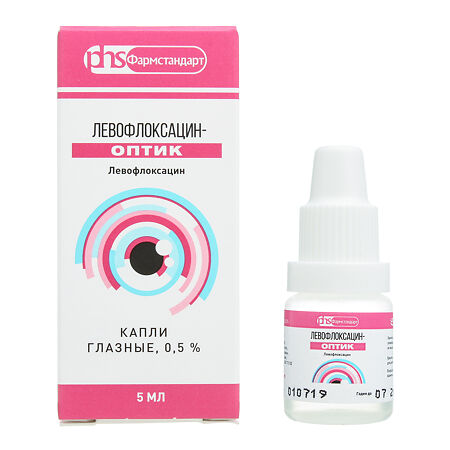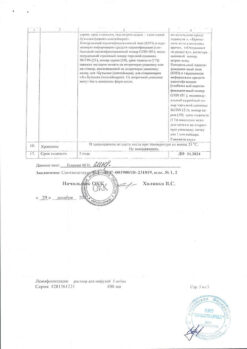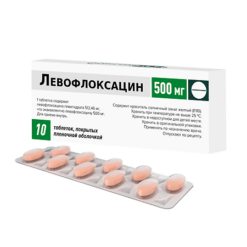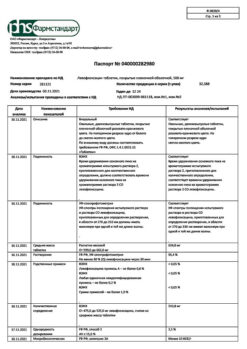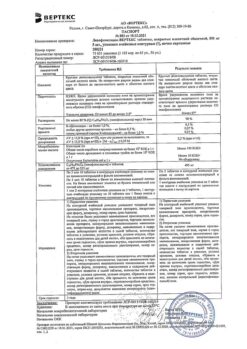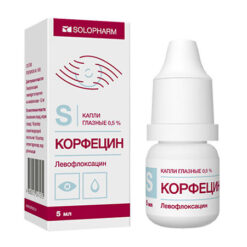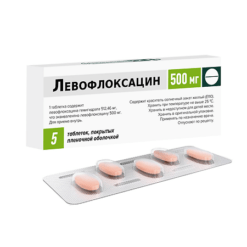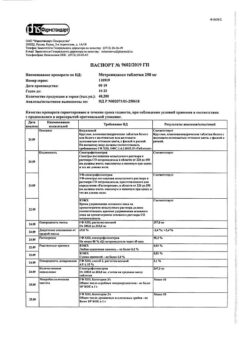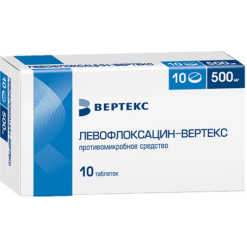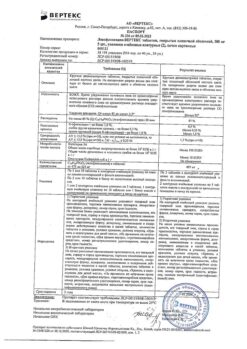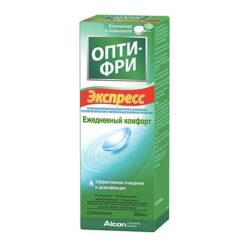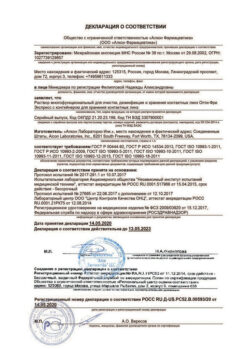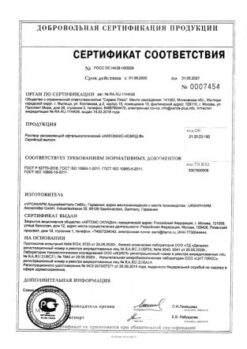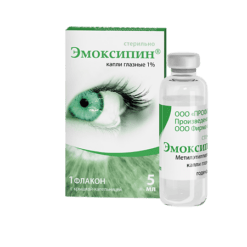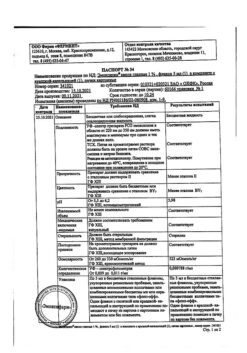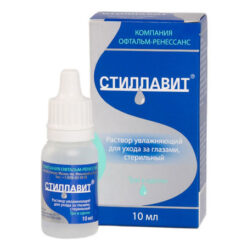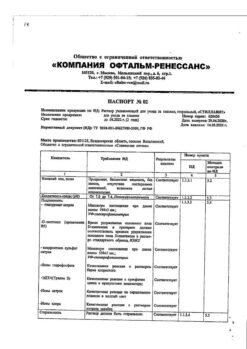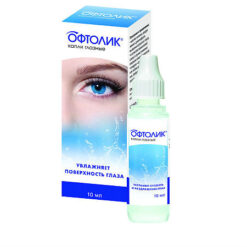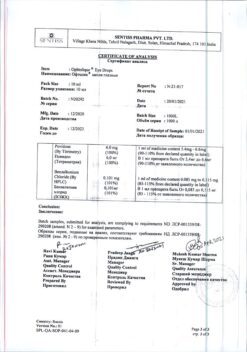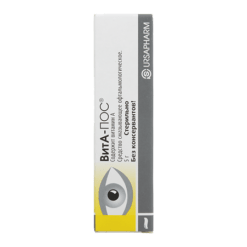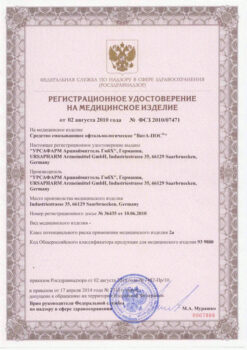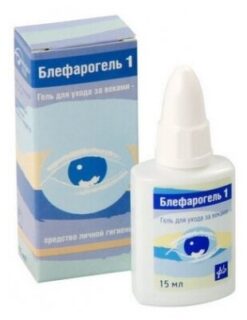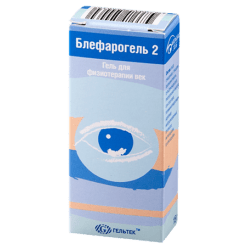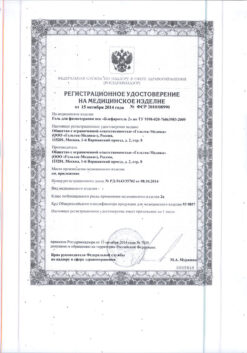No products in the cart.
Levofloxacin-Optic, eye drops 0.5% 5 ml
€4.55 €4.04
Description
Levofloxacin is the L-isomer of the racemic drug substance ofloxacin. The antibacterial activity of ofloxacin refers mainly to the L-isomer.
As an antibacterial agent of the class of fluoroquinolones, levofloxacin blocks DNA-enzyme (topoisomerase II) and topoisomerase IV, disrupts supercoiling and cross-linking of DNA (deoxyribonucleic acid) breaks, inhibits DNA synthesis and causes deep morphological changes in cytoplasm, cell wall and membranes.
Mechanism of resistance development
Resistance to levofloxacin can develop primarily through two main mechanisms, namely a decrease in intracellular concentration of the drug or changes in the targets of action of the drug.
The changes in the targets – the two bacterial enzymes DNA-gyrase and topoisomerase IV are the result of mutations in the chromosomal genes encoding DNA-gyrase (gyrA and gyrB) and topoisomerase IV (ragC and parE; grlA and grlB in Staphylococcus aureus).
Drug resistance due to low intracellular concentration develops as a result of changes in the porin channel system of the outer cell membrane, which leads to decreased entry of the fluoroquinolone into Gram-negative bacteria, or from efflux pumps.
Efflux-mediated resistance has been described against pneumococci (PmrA), staphylococci (NorA), anaerobic and gram-negative bacteria.
Plasmid-mediated resistance to quinolones (determined on the basis of the qnr gene) has been found against Klebsiella pneumoniae and Escherichia coli.
The development of cross-resistance between fluoroquinolones is possible.
Single mutations may not lead to clinical resistance, but multiple mutations cause clinical resistance to all drugs in the class of fluoroquinolones.
Mutations in the outer membrane porins and efflux systems can have broad substrate specificity, affecting several classes of antibacterial agents and leading to multiple resistance.
The efficacy against Gram-positive aerobes – Enterococcus faecalis, Staphylococcus aureus (methicillin-sensitive strains), Staphylococcus epidermidis (methicillin-sensitive strains), Staphylococcus saprophyticus, Streptococcus pneumoniae (incl. ч. multidrug-resistant strains -MDRSP), Streptococcus pyogenes; gram-negative aerobes – Enterobacter cloacae, Escherichia coli, Haemophilus influenzae, Haemophilus paraintluenzae, Klebsiella pneumoniae, Legionella pneumophila, Moraxella catarrhalis, Proteus mirabilis, Pseudomonas aeruginosa, Serratia marcescens and other microorganisms – Chlamydia pneumoniae, Mycoplasma pneumoniae.
With respect to most (≥90%) strains of the following microorganisms in vitro minimum suppressive concentrations of levofloxacin (2 µg/ml or less) are established, but the effectiveness and safety of clinical use of levofloxacin in therapy of infections caused by these pathogens have not been established in adequate and well-controlled studies: Gram-positive aerobes – Staphylococcus haemolyticus, Streptococcus (group C/F), Streptococcus (group G), Streptococcus agalactiae, Streptococcus milleri, Streptococcus viridans; Gram-negative aerobes -Acinetobacter lwoffii, Acinetobacter baumannii, Bordetella pertussis, Citrobacter (diversus) koseri, Citrobacter freundii, Enterobacter aerogenes, Enterobacter sakazakii, Klebsiella oxytoca, Morganella morganii, Pantoea (Enterobacter) agglomerans, Proteus vulgaris, Providencia rettgeri, Providencia stuartii, Pseudomonas fluorescens; gram-positive anaerobes – Clostridium perfringens.
Sensitive microorganisms: aerobic gram-positive microorganisms – Corynebacterium diphtheriae, Enterococcus spp, including Enterococcus faecalis, Listeria monocytogenes, Staphylococcus spp. (coagulase-negative methicillin-sensitive/leukotoxin-containing/ moderately sensitive strains), including Staphylococcus aureus (methicillin-sensitive strains), Staphylococcus epidermidis (methicillin-sensitive strains), Streptococcus spp. groups C and G, Streptococcus agalactiae, Streptococcus pneumoniae (penicillin-sensitive/moderately sensitive/resistant strains), Streptococcus pyogenes, Streptococcus spp. group viridans (penicillin-sensitive/resistant strains); aerobic gram-negative microorganisms – Acinetobacter spp, including Acinetobacter baumannii, Acinetobacillus actinomycetecomitans, Citrobacter freundii, Eikenella corrodens, Enterobacter spp, including Enterobacter aerogenes, Enterobacter agglomerans, Enterobacter cloacae, Escherichia coli, Gardnerella vaginalis, Haemophilus ducreyi, Haemophilus influenzae (ampicillin sensitive/resistant strains), Haemophilus parainfluenzae, Helicobacter pylori, Klebsiella spp, including Klebsiella oxytoca, Klebsiella pneumoniae, Moraxella catarrhalis (beta-lactamase producing and non-producing strains), Morganella morganii, Neisseria gonorrhoeae (penicillinase producing and non-producing strains), Neisseria meningitidis, Pasteurella spp, including Pasteurella canis, Pasteurella dagmatis, Pasteurella multocida, Proteus vulgaris, Providencia spp. including Providencia rettgeri, Providencia stuartii, Pseudomonas spp, including Pseudomonas aeruginosa, Serratia spp. including Serratia marcescens, Salmonella spp.; anaerobic microorganisms -Bacteroides fragilis, Bifidobacterium spp, Clostridium perfringens, Fusobacteriumspp., Peptostreptococcus spp., Propionibacterium spp., Veilonella spp.; other microorganisms – Bartonella spp, Chlamydia pneumoniae, Chlamydia psittaci, Chlamydia trachomatis, Legionella pneumophila, Legionella spp., Mycobacterium leprae, Mycobacterium tuberculosis, Mycoplasma hominis, Mycoplasma pneumoniae, Rickettsia spp., Ureaplasma urealyticum.
Moderately sensitive microorganisms (MPC more than 4 mg/l): Aerobic Gram-positive microorganisms – Corynebacterium urealyticum, Corynebacterium xerosis, Enterococcus faecium, Staphylococcus epidermidis (methicillin-resistant strains), Staphylococcus haemolyticus (methicillin-resistant strains); aerobic gram-negative microorganisms – Burkhoideria cepacia, Campylobacter jejuni, Campylobacter coli; anaerobic microorganisms – Bacteroides thetaiotaomicron, Bacteroides vulgatus, Bacteroides ovatus, Prevotella spp., Porphyromonas spp.
Resistant microorganisms (MPC more than 8 mg/ml): aerobic gram-positive microorganisms – Corynebacterium jeikeium, Staphylococcus aureus (methicillin-resistant strains), other Staphylococcus spp. (coagulase-negative methicillin-resistant strains); aerobic Gram-negative microorganisms – Alcaligenes xylosoxidane; other microorganisms – Mycobacterium avium.
Minimum inhibitory concentrations of levofloxacin for some microorganisms
Microorganism | Sensitive, mg/mL | Resistant, mg/mL | |||||||
Pseudomonas spp. | ≤1 | >2 | |||||||
Staphylococcus spp. | ≤1 | >2 | |||||||
≤1 | >2 | ||||||||
Streptococcus pneumoniae | ≤1 | >2 | |||||||
Haemophilus influenzae | ≤1 | >1 | |||||||
Moraxella catarrhalis < | ≤1 | >2 | |||||||
| Shelf life | 2 years. |
|---|---|
| Conditions of storage | Store in the original package at a temperature not exceeding 25 ° C. Store out of the reach of children. |
| Manufacturer | Lekko ZAO, Russia |
| Medication form | eye drops |
| Brand | Lekko ZAO |
Other forms…
Related products
Buy Levofloxacin-Optic, eye drops 0.5% 5 ml with delivery to USA, UK, Europe and over 120 other countries.

